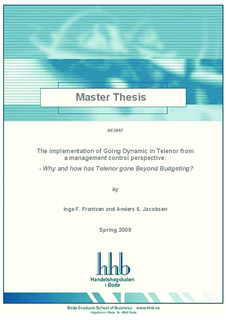| dc.description.abstract | Today’s organization is striving in environments which frequently are characterized by uncertainties and rapid changes. The budget has been, and still is, a management tool most companies use to govern their activities. The critics of the budget have claimed that the budget has lost its relevance in today’s highly competitive environment. Beyond Budgeting is such a concept that claims that organizations needs to replace the budget due to its conflicting purposes.
Telenor is one of the organizations which realized that the budget was inadequate for the company's needs because it did not always contribute in providing the optimal management information. Management realized that the budget was grasping for more than it could handle and introduced Going Dynamic – a management model inspired by the Beyond Budgeting philosophy. We have studied why and how Telenor introduced Going Dynamic by interviewing the project leader for Going Dynamic and employees in two market outlets. Telenor decided to introduce Going Dynamic in the Norwegian organization in 2006. The market outlets were separately responsible for introducing new designs that replaced the budget, which has resulted in some interesting similarities and differences. The study of how Going Dynamic has been introduced in the market outlets has been done from a management control perspective which includes targets, resource allocation and prognoses.
The literature states that each organization’s journey to go Beyond Budgeting is unique, and our study confirms that this is the case even between divisions in a single organization. We found that the budget no longer provided management with the adequate information needed in Telenor’s rapid changing environment. The budget could no longer perform its multiple roles included target setting, resource allocation, and cost management in a way that enabled decision making and follow up. Telenor has separated the targets, resource allocation and prognoses as a result of this. The two market outlets have developed different mechanisms that allow a more dynamic resource allocation. The processes of making prognoses, which aim to reveal gaps towards the targets, are applied differently in the two market outlets. The prognoses have made processes more visible and the incentive structure has been changed. However, there are indications that the budget has not been fully deinstitutionalized yet and the budget-like fixed target setting process seems to hamper Telenor’s ability to allocate resources dynamically to a certain degree. | en |
